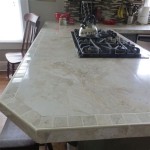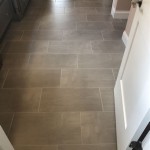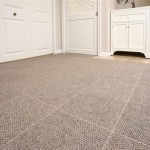Can You Tile Straight Onto Concrete Blocks?
Concrete blocks, sturdy and versatile, form the foundation of many structures, from garden walls to house extensions. Their robust nature often leads to the question of whether they can serve as a direct substrate for tiling. While the short answer is yes, with proper preparation and consideration, tiling directly onto concrete blocks requires a nuanced understanding of the material's properties and potential challenges.
Concrete blocks are inherently porous and susceptible to moisture absorption. This characteristic, while beneficial for certain applications, poses a challenge for direct tiling. Moisture can migrate through the blocks and compromise the adhesive bond between the tiles and the substrate, leading to eventual tile failure. Additionally, concrete blocks can experience movement due to temperature fluctuations and settling, further stressing the tile installation.
Proper surface preparation is paramount for successful tiling on concrete blocks. The blocks must be clean, dry, and free of any dust, debris, or loose mortar. Any efflorescence, a white, powdery deposit caused by migrating salts, should be thoroughly removed using a stiff brush or specialized cleaning solution. High-pressure washing can be employed, but it's essential to allow ample drying time before proceeding.
Addressing the porosity of concrete blocks is crucial. Applying a primer specifically designed for porous substrates is highly recommended. These primers penetrate the surface, sealing the pores and creating a more stable and less absorbent base for the tile adhesive. This step not only improves adhesion but also helps prevent moisture from migrating through the blocks and damaging the tile installation.
The choice of tile adhesive is equally important. A high-quality, polymer-modified thin-set mortar specifically formulated for concrete blocks is essential. These adhesives offer superior bonding strength and flexibility, accommodating minor movements and preventing cracks in the grout and tile. Standard thin-set mortars may not provide adequate adhesion or flexibility for this application.
While tiling directly onto concrete blocks is possible, applying a render coat or a waterproof membrane offers several advantages. A render coat, typically a cement-based mixture, creates a smoother, more uniform surface for tiling. This can simplify the tiling process, particularly for larger format tiles, and improve the overall aesthetic. Furthermore, the render coat provides an additional layer of protection against moisture penetration.
Waterproof membranes, often applied beneath the render coat or directly onto the primed concrete blocks, provide an additional barrier against moisture ingress. This is especially important in areas subject to high humidity or direct water exposure, such as shower walls or external facades. Waterproof membranes ensure long-term durability and prevent moisture-related issues that could compromise the tile installation.
When tiling exterior walls constructed of concrete blocks, further considerations apply. Exposure to the elements, including freeze-thaw cycles and temperature fluctuations, necessitates the use of exterior-grade materials. Exterior-grade tile adhesive and grout are specifically formulated to withstand these harsh conditions and maintain their performance over time. Additionally, selecting tiles suitable for exterior applications is crucial. These tiles are typically more robust and resistant to cracking and fading due to weather exposure.
The size and type of tile also influence the preparation process. Larger format tiles require a flatter, more even surface to ensure proper adhesion and prevent lippage, where adjacent tiles are at different heights. This may necessitate a thicker render coat or more meticulous surface preparation. Similarly, natural stone tiles may require specialized adhesives and sealers to prevent staining and maintain their appearance.
Expansion joints are another crucial element to consider, especially for larger tiled areas. These joints, typically filled with flexible sealant, accommodate movement in the substrate and prevent cracking of the tiles and grout. The spacing of expansion joints depends on factors such as the size of the tiled area, the type of tile, and the expected temperature fluctuations.
Proper curing time is essential after tiling. Allowing sufficient time for the adhesive and grout to cure fully ensures a strong and durable bond. Avoid heavy traffic or loading the tiled surface during the curing period, typically 24 to 72 hours, depending on the specific product used. Following the manufacturer's instructions regarding curing times and procedures is crucial for optimal results.
In conclusion, tiling directly onto concrete blocks can be a viable option with meticulous preparation and the use of appropriate materials. Addressing the porosity of the blocks, selecting suitable adhesives and grouts, and considering environmental factors are essential for achieving a successful and long-lasting tile installation.

Tile Over Blockwork Mike Haduck
:max_bytes(150000):strip_icc()/can-you-install-tile-directly-on-concrete-1822600-04-458f7bb6c78348c1835cf8054ef36553.jpg?strip=all)
How To Install Tile Over Concrete

Tiling Over A Ed Concrete Slab Fine Homebuilding
Shower Pan In Bathroom With Cinder Block Walls Ceramic Tile Advice Forums John Bridge

How To Install Ceramic Tile Over Painted Block Walls For A Shower Ehow
:max_bytes(150000):strip_icc()/can-you-install-tile-directly-on-concrete-1822600-01-8a89ceab1a274fb8ac81890ab7fc6b1b.jpg?strip=all)
How To Install Tile Over Concrete

Can You Lay Outdoor Tiles Over Concrete Premier Porcelain

How To Install Tile On Cinder Block Hunker
When Cementing Tile Why Do People Add Rows To The Cement Instead Of Just Leaving It Smooth Quora
How To Tile Onto Concrete Floors Porcelain Super
Related Posts








